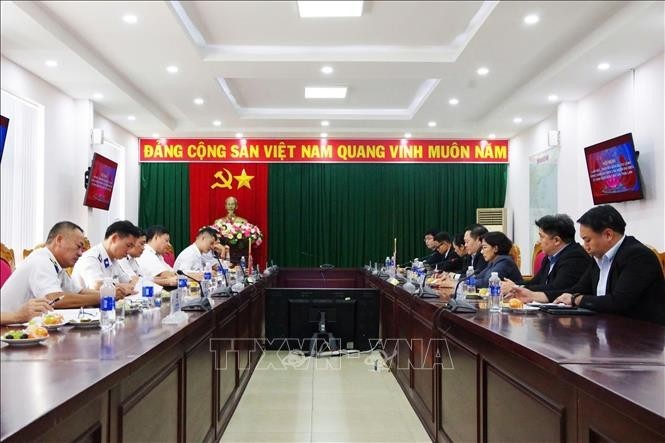A beginner’s guide to HCM City’s street food: Lonely Planet
As Vietnam’s most populous city with many universities, businesses and modern conveniences, Ho Chi Minh City draws people from all over the country, many bringing with them their favourite foods. That, coupled with the city's 24/7, always-on-the-go vibe, means there’s always a wide range of great, cheap street food to be had.
Many of HCMC's street food joints tend to be one-dish stalls, and the cooks have tweaked and streamlined the recipe to create tremendously flavoursome fast food. Following Lonely Planet’s guide - James Pham - to some of Saigon’s most popular street foods.
 |
A close-up of a bowl of bánh cuốn, with two small bowls of orange sauces © James Pham / Lonely Planet
Bánh Cuốn (Steamed Rice Rolls)
Typically eaten for breakfast, these rice rolls stuffed with minced pork and tree ear mushrooms are impossibly light and fluffy, and they are usually made to order. The thin rice flour batter is steamed over a stretched piece of fabric, then delicately folded around the filling. The dish is then served with a heap of blanched bean sprouts, chopped fresh herbs and Vietnamese cold cuts (including a steamed pork ham and sliced rounds of pickled ham), all topped with crispy fried shallots. Add the provided sweet and tangy fish sauce mixture to it all for a great breakfast or anytime snack. Every neighbourhood usually has its own bánh cuốn stand; look for a glass case next to a big steamer.
Phở (Vietnamese Noodle Soup)
The key to Vietnam’s best-known culinary export boils down to a rich, fragrant broth made from simmering beef or chicken bones for hours and flavoured with star anise, cinnamon bark and char-roasted onions and ginger. Choose from beef or chicken, and Saigon (sweeter) or Hanoi-style (lighter) versions. Beef phở can typically include raw sliced beef that’s cooked when it meets the piping hot broth, cooked brisket, meatballs, tripe, flank, fatty brisket and tendon. If you’re not a terribly adventurous eater, the “tái chín” (pronounced: tie cheen) with raw slices of round steak and well-done brisket makes a good combination. Pick the leaves off some fresh herbs (usually basil, rice paddy herb and sawtooth coriander) and add them to the broth to release their aromatic flavours.
Rice Field at 75 Ho Tung Mau Street (mornings only) serves both chicken and beef phở in the shadow of Saigon’s tallest building.
 |
Enjoy HCMC's street scenes while you indulge in some cơm tấm © James Pham / Lonely Planet
Cơm Tấm (Broken Rice)
Originating in Southern Vietnam as a peasant dish, the name cơm tấm refers to its use of broken, unsellable grains of rice that farmers kept for themselves. Topped with shredded pork skin (also a cheap by-product) and scallion oil, this one-plate meal eventually made its way to the big city where more affluent folks added grilled pork chops, fried eggs, and steamed quiche (with egg, minced pork, shredded tree ear mushroom and vermicelli). Pickled carrots and white radish add acidity and crunch, and everything gets doused with a thick sauce made from fish sauce, minced garlic, chili, sugar and lime. People say the smaller grains of rice get coated more with the sauce, giving the dish extra punch.
Follow the wafts of smoky chargrilled goodness to 83 Van Kiep Street, Binh Thanh District for a plate with the works. Save some room, though, as this street is famous for its huge assortment of food stalls.
 |
Two bowls of Hu Tieu Nam Vang. Photo: foody.com
Hủ Tiếu Nam Vang (Phnom Penh-style Noodle Soup)
This noodle soup with a rich pork-based broth is said to have originated in Phnom Penh, Cambodia, and it often includes a plethora of toppings such as minced pork, sliced boiled pork, quail eggs, shrimp, offal and sometimes wontons. A plate of fresh herbs often accompanies the soup, including chives and slightly bitter Chinese celery. Add a dab of sate sauce or pickled garlic to taste. You can choose to get the broth on the side (“khô”, pronounced: khoh), where soy sauce is sometimes added to the dry noodles to make them more savoury on their own.
Try it at Hu Tieu Thanh Xuan at 62 Ton That Thiep Street which has been selling these flavoursome noodles for four generations.
 |
Green papaya salad with beef jerky in Le Van Tam Park, District 1, HCMC. Source: The Blind Cook
Gỏi Đu Đủ (Green Papaya Salad)
Vietnamese aren’t big on Western-style salads with mixed raw vegetables. The dish that comes closest is “gỏi đu đủ”, a heap of shredded green papaya topped with some type of protein (beef jerky, boiled pork or shrimp), fresh herbs, and crispy shrimp crackers, all served with a fish sauce-based dressing for a crunchy, light and healthy snack.
Try it in the afternoons at the southwest corner of Le Van Tam Park (corner of Vo Thi Sau and Hai Ba Trung Streets) where a family has been making just this salad for over 40 years. Grab a seat on the curb and someone will bring you a plate from the glass cart across the street where they’re assembled.
Bột Chiên (Fried Dough)
Fried dough tastes good in any language (think donuts, churros and zeppoles), and Vietnam’s savoury version is no different. Look for a mobile cart with a giant flat griddle where you’ll see steamed cubes of rice and tapioca flour dough being fried over a super-heated flame until crispy. A beaten egg gets added to bind everything together and a handful of chopped scallions are sprinkled on top. Crispy on the outside, soft on the inside, the whole heap gets placed atop a bed of shredded green papaya and doused with a soy sauce-based dressing. You can justify the calories by thinking of it as a salad with croutons.
Try it at Bot Chien Dat Thanh at 277 Vo Van Tan Street.
 |
A woman tends to several pots filled with different-colored sweets © James Pham / Lonely Planet
Chè (Sweet Soup)
Hard to define, “chè” is often translated as a sweet beverage, dessert soup or pudding. To add to the confusion, the same word is used by Northerners to mean “tea”. Basically, though, chè is a cooked, syrupy dessert that sometimes incorporates fruit, but, more often than not, will include ingredients that are not typically associated with sweets like beans, corn, cassava and potato. The sheer varieties of chè are mind-boggling, with some of the more popular versions incorporating bananas, dried longans, or rice flour dumplings stuffed with sweet mung beans, all topped with a dollop of thick coconut milk. Make your way to Chè Mâm Khánh Vy at 242B Su Van Hanh Street for their special tray of 16 types of “chè” for less than USD 4.
A melting pot of three distinct regions of Vietnam, HCMC is truly one of the world’s great street food cities where you could literally eat something different for every meal for months and not repeat a dish. With most street food meals costing just about USD 1, eating your way through the city's urban culinary scene is definitely a highlight of any visit./.
According to Lonely Planet
Most read
Recommended
 Travel
Travel
Hanoi and Incheon to Promote Tourism Products
 Travel
Travel
Vietnam - Unique Destination Allures Indian Tourists
 Travel
Travel
Vietnam Welcomes 40% More International Tourists in 10 First Months of 2024
 Travel
Travel
Foreign Tourists Converge at Hanoi’s Temple of Literature for Cultural and Historical Immersion
Popular article
 Travel
Travel
6,000 International Tourists Visit Vietnam by Sea
 Travel
Travel
Phu Quoc Ranks Second Among Top 10 Best Islands In Asia
 Travel
Travel
Vietnam Among Top Countries Favored By Tourists
 Travel
Travel







